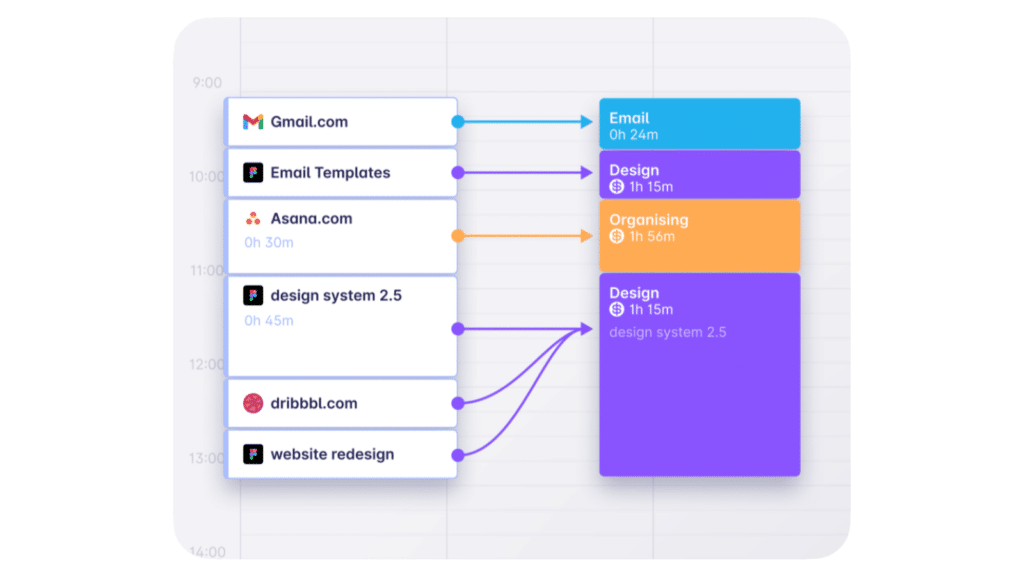Consultant Fees: How Much to Charge for Consulting
Are you finding your way through the complex world of consulting and constantly wondering: How much should I charge for my services?
Determining your consultant fees is more than a matter of numbers; it’s about valuing your expertise and ensuring a sustainable consulting business model.
In this article, we’ll explore the key factors that influence how much you should charge as a business consultant or independent consultant. We’ll give you a few tips and strategies to help you develop a pricing model that works for your consulting projects.
You’ll also learn how using accurate time tracking can make sure your fees are fair and help you make a profit.

Track your billable hours to maximize your income!
How much time do you spent on each project? Check where your time goes and make sure to charge your clients adequately!
What is a consultant fee?
A consultant fee is the compensation that consultants charge for their expertise and services provided to a company or an entity.
These fees vary, adapting to the project’s nature and the services rendered. Common fee structures include hourly, monthly, retainer, and project-based fees.
Moreover, consultants are increasingly embracing value-based pricing, tying fees to the impact and outcomes of their work, not just the hours invested.
These different fee options enable consultants to adjust their rates based on the project’s scope and requirements, as well as the client’s preferences.
Consultants tend to increase their fees if the project involves additional work-related expenses or complexities, much like full-time employees most consultants might ask for a higher salary when taking on new clients with more demanding needs.

How much should you charge? Tips for calculating your consulting fee
This isn’t just about picking a number out of thin air. It’s a calculated decision that hinges on a variety of factors.
For starters, consider how many hours you’ll be dedicating to each project and the pricing methods that best suit your style of work. If you’re a new consultant, this can seem particularly daunting.
You’ll want to look at industry averages as a starting point, but remember, these are just guidelines.
Your fee structure should be tailored to reflect the tangible value you provide to your clients. It’s about understanding the unique skills and expertise you bring to the table and translating that into a fee that’s fair for both you and your clients.
In this section, we’ll dive into how you can effectively balance these considerations to set fees that truly represent the worth of your services.
1. Assess your value
In the consulting world, what you charge as a consultant should reflect your unique expertise and accomplishments.
Most consultants base their fees on their experience and success in their field.
For example, if you’re an accomplished marketing consultant with a track record of increasing client sales, your fees should mirror this level of expertise.
Market demand is also a crucial factor – if your specialty is in high demand, you can command higher fees, aligning with the value you bring to a competitive market.

2. Estimate the workload
For setting consulting fees, it’s crucial to accurately estimate the effort and time your consulting work will demand.
Take, for instance, SEO campaigns that require intensive research and complex strategic planning. Such projects justify higher fees when you charge clients, as they demand more in terms of time and expertise compared to simpler tasks.
When determining your fees, consider factors like the project’s duration, the intensity of the work involved, and any unique challenges it may pose.
This careful assessment ensures that your fees fairly compensate for your dedication and skills while also maintaining appeal for your clients.
Example: SEO consulting
a) Project scope:
- Keyword Research (Identifying 50 high-traffic keywords)
- On-Page SEO (Optimizing meta tags, headers, and content for 20 key pages)
- Backlink Building (Securing 30 high-quality backlinks from authoritative websites)
- Content Strategy (Creating a content calendar with 12 blog posts and 4 infographics)
- Monthly Reporting (Providing detailed analytics and SEO performance updates)
b) Time estimation:
- Identifying 50 high-traffic keywords: 5 hours
- Optimizing meta tags, headers, and content for 20 key pages: 5 hours
- Securing 30 high-quality backlinks from authoritative websites – 20 hours
- Creating a content calendar with 12 blog posts and 4 infographics: 30 hours
- Providing detailed analytics and SEO performance updates: 5 hours
c) Sum up and take the number as your basis for further analysis.

Track time assigned to each client, project and activity to estimate your workload
3. Control your client’s expectations
When you negotiate consulting rates, clear communication with clients about the scope and deliverables of your services is key. For instance, in conducting a comprehensive business analysis, it’s important to clarify what this involves and the expected outcomes.
By aligning your consulting fees based on both the tangible and intangible value you provide, you enhance transparency and foster trust with your clients.
This involves setting clear boundaries and helping clients understand why your fees are structured as they are, based on the value they receive from your work.
Read also: How to get consulting clients
4. Balance costs
As a consulting business owner, it’s essential to have financial savvy when setting your consulting fees.
This means factoring in various potential expenses that can affect your bottom line. These expenses range from operational costs such as software subscriptions and the cost of maintaining office space, to travel expenses for meeting consulting clients.
Additionally, if you’re outsourcing tasks for your consultancy, these costs should also be considered. For those charging retainer fees or requiring an initial fee from clients, it’s crucial to ensure these fees not only cover your costs but also contribute to your business’s growth and profitability.
This strategic approach in pricing helps in maintaining a healthy, thriving consultancy business.
5. Consider the average consulting fees only an insight
In setting consulting fees, it’s important not to rely solely on industry standards. Your pricing structure should be a unique reflection of the value you bring to each consulting project.
Many consultants, especially new ones, might feel compelled to align with industry rates or even offer discounts to attract clients. However, remember that your fees should embody the distinct benefits and exceptional service you provide.
If, for instance, your consulting practice includes extraordinary services like extensive post-project support, your fees should capture this additional value.
This strategic approach not only differentiates your consulting services but also highlights them as a worthwhile investment for your clients, moving beyond the ordinary expectations of the consulting field.

Pricing model overview for business consultants
Understanding how to set your fees is a critical part of being a successful business consultant. It can greatly influence the sustainability and success of your consulting business.
To assist you in this essential aspect, we will explore various pricing models, including different approaches such as hourly rates, project rates, retainer fees, and value-based pricing.
This will provide provide you with the necessary knowledge to select a pricing strategy and consulting rate that aligns well with your expertise, meets your clients’ needs, and fits the market conditions, laying the groundwork for a thriving consulting practice.
1. Consulting fees by hourly rate
Consulting fees by hourly rate is a popular pricing model among consultants. This approach involves charging clients a consulting rate based on the number of hours spent working on their project.
Pros of hourly rate pricing:
- Transparency: Clients clearly understand what they are paying for. Direct Compensation: Consultants are paid for every hour worked.
- Flexibility: Suitable for projects with uncertain or evolving scopes.
Cons of hourly rate pricing:
- Limited earning potential: Income is restricted by the number of hours worked.
- May not reflect true value: High expertise tasks completed quickly might be undercompensated.
When hourly rates are most effective:
- Short-term consulting project Ideal for work with a limited or defined timeframe.
- Projects with variable involvement: Useful when the extent of the consultant’s involvement may change over time.
2. Consulting fees by project rate
Project-based pricing offers a structured approach for consultants, especially new ones and small businesses, looking for a consistent income model.
This services-based strategy involves setting a per-project consultant rate, allowing for clear and predictable financial planning.
Pros for project-based pricing:
- Consistent income: Offers a stable and predictable income for each project, making financial planning more straightforward.
- Clarity in services-based pricing: Clients understand the total cost for your services upfront, which is especially advantageous for new consultants who are establishing trust.
- Efficiency incentive: Encourages you to work smarter and more efficiently, as the rate is fixed regardless of the time spent.
Cons for project-based rate pricing:
- Risk of underestimating project scope: There’s a possibility of earning less if the project takes more time than expected.
- Flexibility limitations: Any changes or additional requests in the project scope might necessitate renegotiating the rate.
Ideal scenarios for project-based rate pricing:
- Clearly defined projects: This model works best for projects with specific goals and a well-understood scope.
- New consultants: It’s particularly suitable for new consultants as it provides a clear and straightforward pricing strategy that’s easy for clients to understand.

3. Consulting fees by retainer
Consulting fees by retainer involve clients paying a pre-paid, regular amount, typically a monthly fee, to retain a consultant’s services over a period.
This method differs from charging per hour or an hourly wage, offering a more stable and predictable income.
Pros of monthly retainers:
- Steady income: Provides a consistent monthly income, unlike fluctuating hourly wages.
- Client commitment: Ensures client commitment over a longer term, offering stability that other consultants may not have.
- Predictability: Allows for better financial planning and forecasting due to regular monthly retainers.
Cons of retainer fee pricing:
- Limited flexibility: You might be bound to specific terms of service, reducing the opportunity to take on other projects.
- Set consulting rate: The monthly fee might not always reflect the total hours or effort put into the work, especially if the workload increases.
When monthly retainers work best:
- Long-term projects: Ideal for ongoing projects requiring continuous input or maintenance.
- Established client relationships: Works well when there is an established trust and understanding of the value you bring, making a monthly retainer more justifiable.
- Regular consultation needs: Suitable for clients who require consistent and regular consulting services, ensuring they have access to your expertise when needed.
4. Value-based fees
Value-based fees in consulting are a unique approach where your consultancy fees are tied to the impact your work has on your client’s business, rather than just charging per hour or basing it on an annual salary model. It’s about the value and results you deliver.
Pros of value-based fee pricing:
- Direct link to outcomes: Your earnings reflect the real difference you make in your client’s company.
- Higher earning potential: If your work significantly boosts your client’s cashflow or business growth, you could earn more than standard hourly rates.
- Greater client satisfaction: Clients often appreciate this model as they pay for the results you bring, not just the time you spend.
Cons of value-based project fee:
- Measuring value can be tricky: Figuring out and agreeing on the exact value you provide is more complex than simple hourly billing.
- Reliant on client success: Your income might hinge on factors outside your control, such as how well the client implements your strategies or external market conditions.
Ideal situations for value-based pricing:
- Projects with clear impact: This model is perfect when your consultancy work directly leads to substantial business improvements.
- Strong client relationships: It’s most effective with clients who already trust in your ability to deliver valuable results.
- Projects with measurable success: Best suited for situations where the success and impact of your work on the client’s revenue can be clearly quantified.

I am a new consultant: How to build a pricing structure for new clients?
As a new consultant in the consulting business, building a pricing structure for new clients involves several key considerations. Firstly, as an independent consultant, you might be tempted to set a rate per hour that mirrors your former salary from a corporate job.
However, remember that consulting often entails additional expenses and uncertainties. Consider factors like the scope of each project, the market rate for similar services, and the specific needs of your clients.
Start by calculating your desired annual income based on your former salary, then factor in costs like personal expenses, business expenses, taxes, and the time you’ll spend on non-billable activities. This calculation can help you determine a baseline hourly or project charging rate.
It’s also important to be flexible and open to adjusting your consulting rates as you gain more experience and better understand the value you provide to your clients.
The best tips to increase consultant fees
Here are some tips on how you and other consultants can increase consultant fees:
1. Evaluate your client’s environment and choose the right time to increase your fee
Before proposing a fee increase, assess your client’s current business situation. If they’ve recently had successes, like launching a new product or entering a new market, it could be a good time to discuss raising your fee.
Ensure the timing aligns with their financial stability to avoid proposing an increase during their lean periods.
2. Offer additional services to justify higher fees
Enhance your value by offering supplementary services. For instance, if you specialize in marketing, add a detailed competitor analysis or a digital marketing plan.
Explain how these additional services will benefit the client, thereby justifying the higher fee.
3. Justify fee increases with documented achievements
Prepare a list of your contributions that have positively impacted the client, such as successful projects or growth metrics. This evidence can be a strong foundation for negotiating higher fees, showing the client your value.
4. Choose between one-time or periodic fee increases
Decide whether a one-time fee increase for a specific project or a regular, incremental fee increase (like an annual adjustment) suits your situation best.
This will depend on the nature of your work and the client’s expectations.
5. Invest in your expertise to command higher fees
Continuously upgrade your skills relevant to your consulting area. Whether through advanced courses or attending industry conferences, improving your expertise can be a solid reason for increasing your fees.
6. Discuss ROI and COI with your clients
Have open discussions with your clients about the Return on Investment (ROI) and Cost of Inaction (COI).
Illustrate how your services have improved their business or how your strategies can avert potential losses, reinforcing the value you bring.
7. Brand and promote your services for higher fees
Work on building a strong personal or business brand. Engage in networking, create insightful content, or speak at industry events to increase your visibility and credibility.
A stronger brand presence can often support higher consulting fees.

Importance of time tracking for consultants
Effective time tracking is a crucial strategy for increasing consulting fees, whether you’re operating solo or with a team.
By meticulously tracking every hour dedicated to a project, service, or task, you not only ensure profitability but also open the door to raising your consulting fees further.
Did you know that adopting a consultant time-tracking tool is the most accurate way to track your billable time?
1. Maximize your profits through accurate billing
Accurate monitoring of billable hours through time tracking enables you to bill clients more efficiently and accurately.
This precision not only streamlines the client billing process but also provides clear insights into your profitability, allowing you to adjust your fees accordingly.
Read also: The best customer billing software
2. Transparency leads to trust and higher fees
Implementing a robust time tracking system allows you to document all billable time transparently, detailing every aspect of your work.
This level of transparency builds trust and satisfaction with your clients, laying the groundwork for long-term relationships and the potential to negotiate higher fees to increase your business profitability.
3. Improved communication enhances value perception
With time tracking software, you can provide detailed reports of the time spent on a project, ensuring clear and open communication with your clients.
This clarity helps clients understand the extent of your efforts, potentially leading to an appreciation of your work’s value and a willingness to accept higher fees.
4. Focus increases perceived value
Time tracking helps you stay focused on the task at hand, preventing multitasking and dips in productivity. This focused approach can lead to higher-quality work, which in turn can justify higher consulting fees.
5. Detailed insights for strategic pricing
The detailed analysis provided by time tracking tools helps you understand how much time is spent on specific tasks.
This insight is invaluable for evaluating your consulting fees and identifying areas where you can increase hourly fee based on the intensity and complexity of the work involved.
Track billable time with the lowest possible effort
Are you tracking billable hours with pen and paper or Excel and timesheets eat up several hours a month? The good news is – you can speed it up and create timesheets in under 1 minute a day.
For that, you need Timeular – a dedicated time tracking app embraced by thousands of consultants around the world. Why do consultants fall for Timeular?
Multiple time tracking methods, including automatic time tracking
With Timeular, you can pick one of many smart time tracking methods that best align with your workflows and schedule. You can track time automatically, or with a physical Tracker.
You can use keyboard shortcuts, or manual entries. Whatever works best for you!
All the methods are fast, user-friendly, and 100% secure.
Automatic time tracking
Thanks to automatic time tracking you can fill in your time sheets automatically based on app usage, visited websites and scheduled calendar events. The time is tracked not by you, but for you!

What is the physical Tracker?
Timeular is widely known for it’s physical time tracking cube which is connected to the app via Bluetooth.
You don’t need to open the app to start or stop tracking the time of a particular task. Just flip your personalized Tracker, which sits on your desk fostering a time-tracking habit.
With the Tracker, you can track 1,000+ different activities.

How does it work? Personalize each side of the Tracker with colorful stickers and pens, and simply flip the cube to the side to start tracking the time of a particular project or task.
Please note: While the physical tracker adds a touch of fun to the time tracking process, you don’t need it to use the Timeular software.
Tracking billable and non-billable time is automated
You can easily label each task as billable or non-billable to track the time spent on each project and client. Add hourly rate to each task or team member and the costs will be calculated automatically.
This helps to keep track of project costs, ensures accurate project billing, and provides insights about your team’s efficiency.
- Learn more about the Timeular billable hours tracker.

Track time with the lowest possible effort. Track time with Timeular
You can finally keep project budgets in check
To track the time of specific projects or tasks, just add the number of hours planned for each project.
The app will let you know when you are approaching certain limits to keep you away from overspending and overservicing your clients.
3,000+ integrations
Timeular integrates with 3,000+ thousand tools, including popular project management software or invoicing apps. Use one of native integrations or build your own, using Timeular API.

Conclusion
Throughout this article, you can take on many different tips and insightful advice that will help you on your quest as a consultant in a competitive market. Of course that the most straightforward answer would be the exact formula to calculate your consulting fees, but the truth is that many elements impact it significantly.
To secure growth, experience, and success in consulting firm, you need to analyze your value and evaluate the best and most profitable strategy to determine your consulting fees.
Once secured, it’s time to explore the market and stand out to potential clients.
FAQ
Do consultants offer discounts?
Many business consultants, particularly those in small consulting firms, may offer discounts to align with the cash flow constraints of small businesses, while balancing how many hours of consulting work they can realistically provide.
As a business consultant, can I offer different pricing options to choose from?
Consultants charge different fees depending on their agreement with potential clients. When running a consulting business, you need to learn how to negotiate consulting rates.
One of the methods of negotiation is to let the client choose the preferred billing option: a weekly pay, per hour payment or a monthly retainer. Make sure that you adjust the pricing accordingly.
How do consulting fees differ between a solo consulting business and a larger firm providing consulting services?
A solo consulting business often has more flexibility in setting consulting fees and may offer lower rates due to lower overhead costs, whereas larger firms typically have standardized pricing structures and potentially higher fees due to their extensive resources and broader expertise.
You might be interested in the following:


